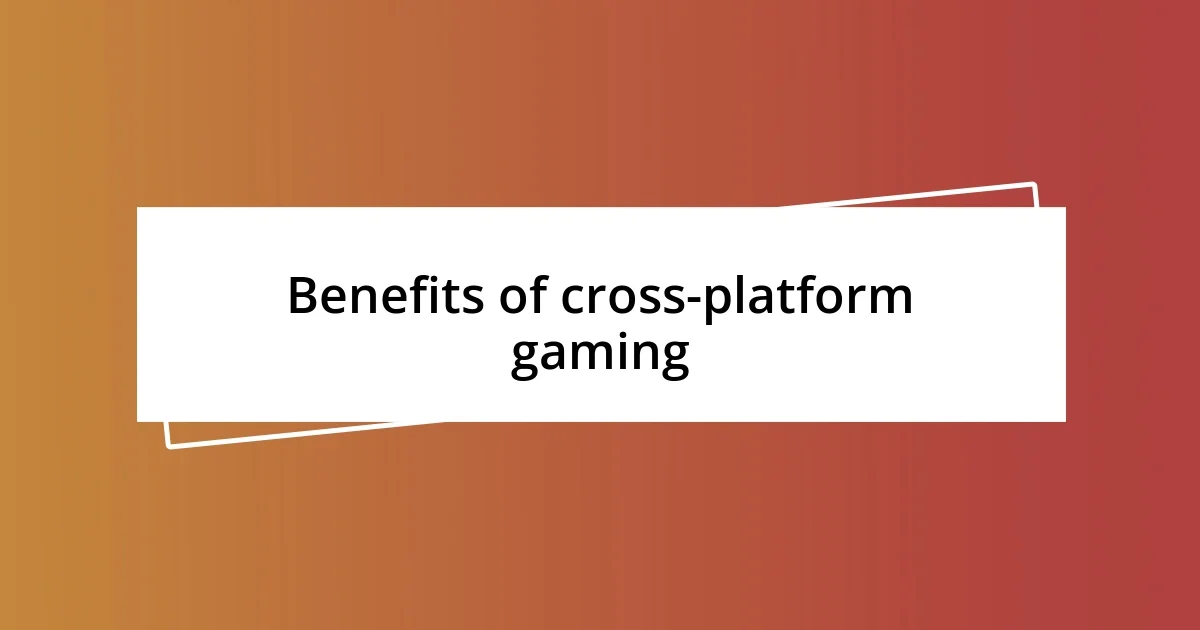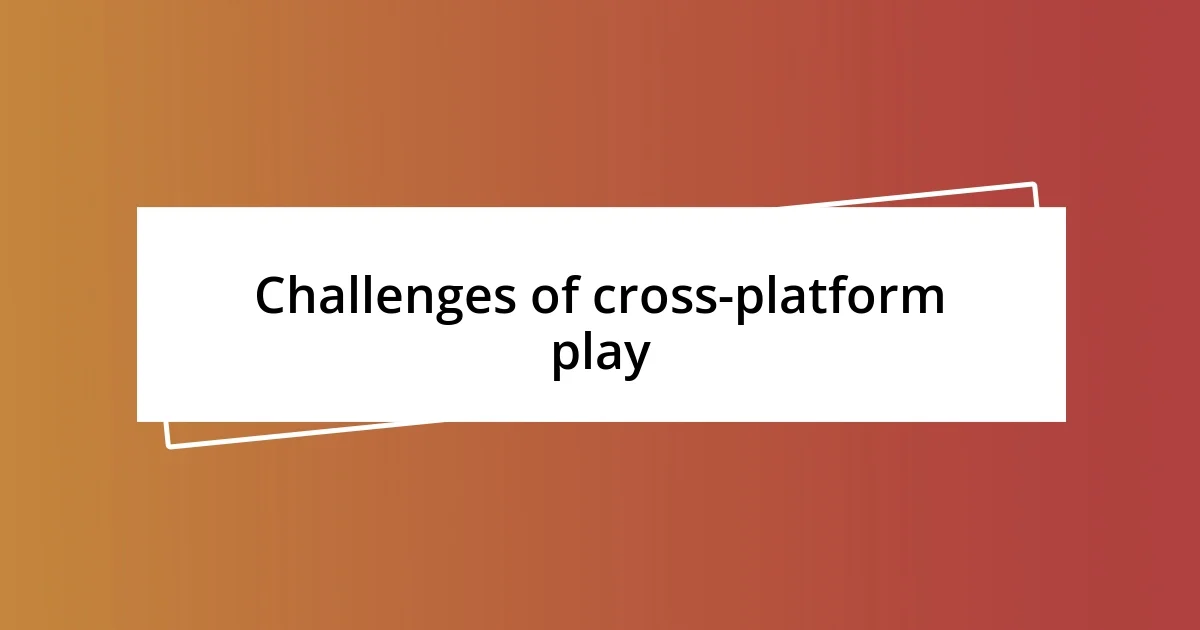Key takeaways:
- Cross-platform play enhances gaming by eliminating barriers between devices, expanding player bases, and fostering a vibrant community.
- Challenges like gameplay imbalance, technical issues, and security concerns need to be addressed for a fair and enjoyable cross-platform experience.
- The future of cross-platform gaming looks promising, with potential innovations aimed at enhancing social dynamics and balancing gameplay across different platforms.

Understanding cross-platform play
Cross-platform play allows players on different gaming devices—like consoles, PCs, and mobile—to engage with each other seamlessly. I remember the excitement I felt when I first played Fortnite with friends who were on PlayStation while I was on my PC. It opened my eyes to the community aspect of gaming; it felt like a big digital hangout where we could compete, strategize, and simply have fun, no matter our system of choice.
You might wonder, why is cross-platform play significant? From my perspective, it enhances the gaming experience by breaking down barriers. I often think about how frustrating it can be when you have friends who love the same game but can’t play together because they’re using different platforms. This inclusive feature not only boosts player numbers but also creates a more vibrant and diverse community.
Moreover, the technological hurdles that once seemed insurmountable are now being tackled by developers. I recall the anticipation leading up to the announcement of cross-play for Rocket League. The moment it became available, I felt a rush of excitement, knowing everyone could jump into a match together regardless of their device. It’s a prime example of how evolving technology can unite gamers, turning solitary play into shared adventures.

Benefits of cross-platform gaming
When it comes to cross-platform gaming, the first benefit that stands out is the expanded player base. I’ve often found myself frustrated when I want to team up with friends but discover they’re on a different console. The beauty of cross-play is that it eliminates this barrier, allowing us to connect and enjoy games together, regardless of our choices in hardware. The thrill of joining a match with friends from all walks of gaming life—be it PC, Xbox, or PlayStation—only heightens the excitement.
Another advantage is the longevity it brings to games. I remember diving into Minecraft with friends on various platforms, and we all contributed to building our dream creations in one shared world. This not only enriches gameplay but also fosters a community spirit that keeps players engaged for longer periods. Developers can focus on enhancing the gaming experience instead of segmenting their audience, which ultimately leads to updates and content that benefit everyone.
Lastly, there’s something incredibly rewarding about being part of a united gamer community. I’ve had countless evenings spent on Discord, chatting with gamers all over the world who I would never have crossed paths with in a traditional setup. Cross-platform play makes gaming feel like a global gathering; it’s about collaboration rather than competition, which is something I cherish.
| Benefit | Explanation |
|---|---|
| Expanded Player Base | Eliminates barriers between platforms and allows friends to play together. |
| Increased Game Longevity | Encourages ongoing engagement and updates from developers for a unified audience. |
| Community Spirit | Fosters connection and collaboration among players from diverse backgrounds. |

Challenges of cross-platform play
While the benefits of cross-platform play are evident, there are significant challenges that developers and players must navigate. One obstacle I’ve noticed firsthand is the imbalance in gameplay experience. For instance, when I played Call of Duty with friends across different platforms, the differences in aim-assist settings made it clear that players using consoles had a distinct advantage. It can be frustrating to feel outmatched simply because of the platform someone is playing on.
Moreover, there are technical issues related to matchmaking and server stability. Occasionally, I’ve experienced lag or disruptions when connecting with players on various platforms, leading to less enjoyable gaming sessions. Here’s a quick overview of key challenges:
- Gameplay Imbalance: Variations in control schemes can create a disadvantage for certain players.
- Technical Limitations: Network issues can arise when connecting players on different systems.
- Compatibility Issues: Not all cross-platform games support all devices equally, limiting the experience.
- Security Concerns: Cross-platform connections can heighten risks for account breaches if not managed properly.
Even with these challenges, the potential for cross-platform play to evolve is promising. As developers continue to innovate, I remain hopeful that the gaming landscape will adapt to create a balanced and enjoyable experience for everyone involved.

Popular games supporting cross-play
Among the multitude of games embracing cross-play, Fortnite stands out as a trailblazer. This battle royale sensation allows players from all platforms—be it PC, Xbox, PlayStation, or mobile—to jump into the same matches. I fondly recall the excitement of dropping into a game with my friends, regardless of the platform they were on. It was thrilling to strategize together, knowing that the only limit to our gaming experience was our own skill and creativity. Isn’t it exhilarating to think that no one is left out because of their choice of system?
Another noteworthy title is Rocket League, where the fusion of cars and soccer captures the imagination of players everywhere. I’ve spent countless hours mastering the art of aerial shots in this game, and the fact that I could easily team up with friends on different consoles made every victory even more rewarding. The camaraderie forged during those matches transcends the screen, creating shared memories that last beyond the game itself. How many times have you celebrated with friends over a last-minute goal? That rush is something special, and cross-play makes it all possible.
Minecraft, with its limitless creative potential, shines as yet another popular cross-play game. I still remember the excitement of collaborating with friends crafting epic builds in the same world, despite each of us using different platforms. There’s something magical about building together, whether it’s a grand castle or a cozy little house in the woods. It’s moments like these that remind us of the fundamental joy of gaming: connecting with others. Why limit ourselves to a single platform when we can create magical experiences together, no matter where we play?

How to enable cross-platform features
To enable cross-platform features, the first step involves ensuring that the game supports this functionality. In my experience, when developers implement a unified gaming environment, it typically requires backend adjustments to the server architecture and framework. I’ve seen games take varying approaches—some rely on dedicated servers, while others use peer-to-peer connections to facilitate smooth interactions across platforms.
Additionally, setting up account linking can be crucial. I remember the moment I linked my Epic Games account for Fortnite; it felt rewarding to jump right into matches with friends from different consoles. This account management ensures that players retain their progress and purchases, which enhances the overall experience. Have you ever lost your hard-earned achievements because you switched systems? That can be disheartening, so it’s essential for developers to prioritize seamless account integration.
Lastly, developing a robust matchmaking system is vital. I’ve often found myself frustrated with games that don’t balance players based on their equipment and skill levels. Effective matchmaking can alleviate some of the gameplay imbalances mentioned earlier. By allowing players of similar skills and control styles to compete against each other, games can provide a more equitable platform where everyone feels they have a fair shot at victory. If you’ve ever experienced a match where it felt like you were outclassed by a player on a completely different setup, you know how important this is.

Community impact of cross-platform play
The impact of cross-platform play on the gaming community is truly significant. I’ve witnessed firsthand how it fosters inclusivity, allowing friends and family to connect regardless of their preferred gaming device. It’s so rewarding when I can invite a friend on Xbox to join my gaming session while I’m on PC—it strengthens friendships and encourages social interaction. Doesn’t it feel comforting knowing that the barriers of choice no longer hold us back from enjoying our favorite games together?
Moreover, cross-play cultivates a diverse player base, enriching the gaming experience. I remember a time in a cross-platform match of Fortnite. The variety of play styles and strategies brought in by different platforms made each encounter unique and unpredictable. Engaging with players who have different experiences often leads to unexpected teamwork and learning opportunities. Have you ever picked up new tricks from players who approached the game differently? That blend of strategies is something I value deeply in gaming.
Another aspect to consider is how cross-platform play can enhance community support and longevity for games. I’ve been part of vibrant communities that are united by shared experiences across various platforms. When a game like Rocket League thrives on cross-platform capability, players extend its life by continuously engaging with its community—sharing tips, strategies, or simply enjoying the thrill of competition together. Isn’t it fascinating how a single feature can breathe new life into our gaming experiences?

Future of cross-platform gaming
As I think about the future of cross-platform gaming, I can’t help but feel a sense of excitement. Imagine a world where your friend on a PlayStation, your cousin on an Xbox, and you on a PC can seamlessly team up and strategize together in real time. That potential to unite players across platforms not only opens doors to richer gameplay but also creates a more vibrant gaming community. Isn’t that something many of us have longed for?
Looking ahead, I foresee more developers jumping on the cross-play bandwagon. In my experience, this shift could pave the way for new innovations that enhance social dynamics in gaming. Just think about it—game developers might design features specifically to leverage the strengths of different platform controls. Have you ever noticed how a mouse and keyboard setup can elevate precision in shooting games? Balancing these elements could lead to thrilling competition and deeper team strategies.
However, the road to cross-platform gaming isn’t without its bumps. There’s always the challenge of ensuring fair play, especially when considering varying performance capabilities across devices. I remember playing a competitive match once, where the disparity in hardware became glaringly obvious. It made me question whether true fairness can ever be achieved. So, how do developers address this concern? Finding equitable solutions will be essential as we move toward a future where cross-platform play is not just an option but a staple in our gaming culture.












